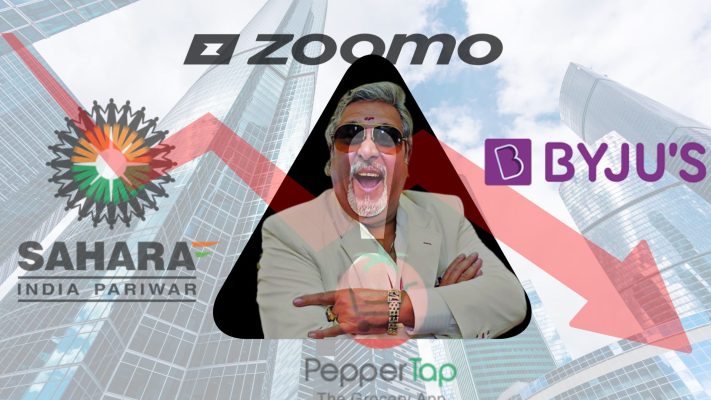
Indian entrepreneurship has always been a bit of Pandora’s box. While it may have given us some real heroes over the decades, today, we celebrate the zeros. Forget billion-dollar valuations; these are billion-rupee blunders where leaders threw both caution and common sense to the wind. From airlines that nosedived faster than an Indian dad’s mood when you change the channel during an Ind-vs-Pak cricket match to edtech empires that crumbled quicker than a roadside pani puri, here are India’s top 10 entrepreneurial disasters that made us say, “Seriously, dude?” Grab some popcorn and chai—this is going to be spicy.
1. Vijay Mallya (Kingfisher Airlines): Champagne Dreams, Chai Budget
The prodigal popat of the Indian business scene, Mallya blew cash on cricket sponsorships, lavish lifestyles, and premium experiences despite losses that kept mounting exponentially. Eventually and inevitably, Kingfisher Airlines went bankrupt, with Mallya disappearing faster than creditors chasing billions. He operated like the rich uncle at every Indian wedding, splashing money around until reality caught up and handed him India’s most expensive eviction notice.
2. Subrata Roy (Sahara): The Great Debenture Debacle
Roy illegally raised billions through OFCDs, hoping regulators were busy sipping chai. When SEBI finally woke up, Sahara was drowning in legal battles and investor fury. Roy treated financial regulations like wearing a helmet while driving a car in U.P.—completely optional until the traffic cop laughed and wrote a challan.
3. PepperTap: The Tech Trainwreck
PepperTap recklessly expanded without ensuring reliable technology, leading to frequent app crashes and enraged customers. Within a year, the entire operation collapsed. PepperTap expanded faster than aunties spreading gossip, only to crash quicker than Wi-Fi during a critical Zoom call.
4. Zoomo: Pricing Strategy That Backfired Spectacularly
Zoomo introduced separate charges for car inspections, thinking customers would appreciate the transparency. Instead, sales nosedived, and the company shut down shortly after. Splitting fees was like charging extra for chutney with dosa—customers weren’t amused, and Zoomo folded quicker than a poorly flipped dosa.
5. Rahul Yadav (Housing.com): The Kamikaze CEO
Rahul Yadav publicly fought investors and impulsively distributed company shares, assuming invincibility. This led to his firing, company turmoil, and eventual takeover. Rahul behaved like a Bollywood hero in a corporate soap opera—lots of drama, minimal logic, swiftly booted off stage.
6. Chetan Vashistth (Adleaf Technologies): Financial Planning? Nah.
Chetan blew through company funds with no budget in sight, quickly depleting resources and causing operational collapse. He ran finances like an uncle at a wedding bar—free-flowing until reality hit and sobered him up rapidly.
7. Deepak (Autto.in): Ads Without a Plan
Deepak poured massive funds into advertising without sustainable growth strategies, burning through cash rapidly. Predictably, Autto.in collapsed under the financial strain. His marketing budget vanished quicker than fireworks during Diwali—short-lived excitement, plenty of smoke, and lasting regret.
8. FreshConnect: Spreading Thinner Than Dosa Batter
FreshConnect aggressively expanded across multiple cities without the necessary resources or staffing, resulting in unsustainable cash burn and rapid closure. They attempted to juggle multiple cities like a street performer at Juhu Beach, except with zero coordination, leaving them scrambling faster than roadside vendors spotting police.
9. InoVVorX: Cash Flow Blindness
Ignoring financial tracking and cash flow management, InoVVorX suffered a complete financial meltdown, with founders losing their personal savings. They handled finances like a chaotic Indian TV serial—random twists, no logic, and eventual disaster, leaving their balance sheets scarier than a Ramsay horror flick.
10. Raveendran Byju (Byju’s): Billion-Dollar Debt Disaster
Byju’s borrowed a massive $1.2 billion loan without a sustainable repayment strategy, leading to crippling debt, legal battles, and a dramatic valuation plunge. They treated debt casually, like buying a smartphone on EMI—until collectors knocked harder than Mumbai monsoons. Byju’s now scrambles to rewrite the syllabus on financial disasters.
Lessons Learned: Or Did We?
These monumental missteps reveal a common thread—overconfidence mixed with financial illiteracy and reckless ambition. Indian entrepreneurship often rides high on enthusiasm, optimism, and a sprinkle of jugaad—but as we’ve seen, jugaad isn’t always a substitute for planning and common sense. These cautionary tales prove clearly: ambition without strategy is like eating pani puri from a questionable street vendor—thrilling, but likely to end badly.
The Indian Startup Scene: Boom or Bust?
India’s startup ecosystem is a rollercoaster filled with daring entrepreneurs, breathtaking innovations, and catastrophic failures. For every unicorn making headlines, dozens quietly crash. Behind each failed startup lie inflated egos, reckless spending, and strategies thinner than street-side chai.
Ultimately, these disasters are stark reminders that innovation needs discipline. Like an overconfident batsman taking risky shots, reckless entrepreneurs inevitably face reality—and it’s usually not pretty. For Indian startups to avoid future disasters, they’ll need more than dreams—they’ll need careful execution, realistic goals, and the humility to learn from past mistakes.
Until then, we have these spectacular failures to remind us that sometimes the road to success is paved with unforgettable lessons. Pass the chai—the ride isn’t over yet.